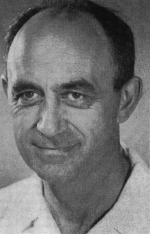Enrico Fermi
physicist, b. 29 September 1901 (Rome, Italy), d. 28 November 1954 (Chicago, USA)
 Enrico Fermi was the youngest child of Alberto Fermi, a Chief Inspector of the Italian Ministry of Communications. His talents in mathematics and physics were recognized early, and he received a scholarship to attend a high school associated with the University of Pisa. In 1922 received his doctorate from that university with a thesis on X-rays. A government scholarship took him to Göttingen, then a centre of nuclear science, a Rockefeller scholarship to Leyden in Holland. He returned to Italy when he was appointed lecturer in mathematical physics and mechanics at the University of Florence.
Enrico Fermi was the youngest child of Alberto Fermi, a Chief Inspector of the Italian Ministry of Communications. His talents in mathematics and physics were recognized early, and he received a scholarship to attend a high school associated with the University of Pisa. In 1922 received his doctorate from that university with a thesis on X-rays. A government scholarship took him to Göttingen, then a centre of nuclear science, a Rockefeller scholarship to Leyden in Holland. He returned to Italy when he was appointed lecturer in mathematical physics and mechanics at the University of Florence.
In Florence Fermi developed the statistics, now known as the "Fermi statistics", for predicting the characteristics of electrons under certain conditions. As a result he was elected Professor of Theoretical Physics at the University of Rome, a post he took up in 1927 and held until 1938.
The discovery of an electrically neutral particle - the neutron - in 1932 and the development of artificially induced radioactivity by Frédéric and Irène Joliot-Curie in 1934 led Fermi to turn from theoretical physics to experimentation. He demonstrated that nuclear transformation occurs in almost every element subjected to neutron bombardment. This work resulted in the discovery of slow neutrons, nuclear fission and the production of transuranic elements, elements lying beyond the range of the Periodic Table as it was known at the time.
In 1938 Fermi was given the Nobel Prize in Physics. The Mussolini government gave him permission to travel to Sweden to collect the prize, and Fermi and his wife, who were intellectually opposed to fascism, used the opportunity to emigrate to the USA, where he was appointed Professor of Physics at Columbia University (New York) in 1939.
When news reached the USA that Hahn, Meitner and Strassmann had unravelled the details of nuclear fission and Meitner had shown that huge amounts of energy are released in the process, their experiments were repeated at Columbia University. Fermi discussed the implications with Niels Bohr, and both realized the possibility of a nuclear chain reaction. Fearing that Hitler's Germany would use this discovery to build an atomic bomb, president Roosevelt ordered the development of such a bomb (the "Manhattan Project"). The task to produce the first chain reaction was assigned to Fermi and achieved at the University of Chicago on 2 December 1942.
Fermi became American citizen in 1944 and Distinguished Service Professor for Nuclear Studies at the Institute for Nuclear Studies of the University of Chicago in 1946. He continued to work on the properties of nuclear particles and high-energy physics.
Fermi received numerous honours during his lifetime. Fermium, element number 100, was named in his honour. The USA established the Enrico Fermi Award of $25,000, of which Fermi was the first recipient in 1954.
References
Jaffe, B. (1995) Enrico Fermi, Encyclopaedia Britannica 15th ed.
Nobel e-Museum, the Official Web Site of The Nobel Foundation (2004) Enrico Fermi. http://www.nobel.se/physics/laureates/1938/fermi-bio.html (accessed 25 July 2004); based on Nobel Lectures. Physics 1901-1921, Elsevier Publishing Company, Amsterdam, 1967.
home
 Enrico Fermi was the youngest child of Alberto Fermi, a Chief Inspector of the Italian Ministry of Communications. His talents in mathematics and physics were recognized early, and he received a scholarship to attend a high school associated with the University of Pisa. In 1922 received his doctorate from that university with a thesis on X-rays. A government scholarship took him to Göttingen, then a centre of nuclear science, a Rockefeller scholarship to Leyden in Holland. He returned to Italy when he was appointed lecturer in mathematical physics and mechanics at the University of Florence.
Enrico Fermi was the youngest child of Alberto Fermi, a Chief Inspector of the Italian Ministry of Communications. His talents in mathematics and physics were recognized early, and he received a scholarship to attend a high school associated with the University of Pisa. In 1922 received his doctorate from that university with a thesis on X-rays. A government scholarship took him to Göttingen, then a centre of nuclear science, a Rockefeller scholarship to Leyden in Holland. He returned to Italy when he was appointed lecturer in mathematical physics and mechanics at the University of Florence.